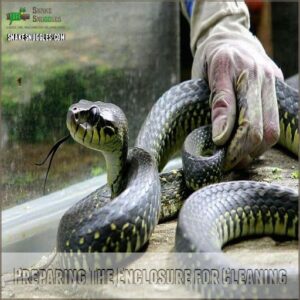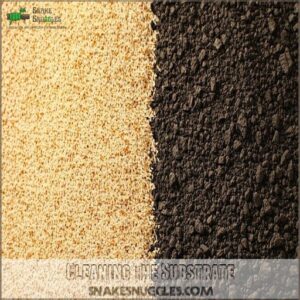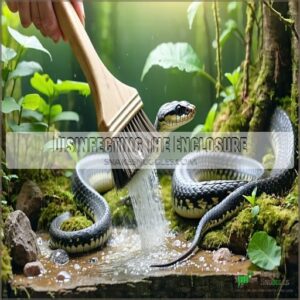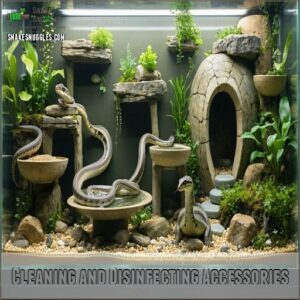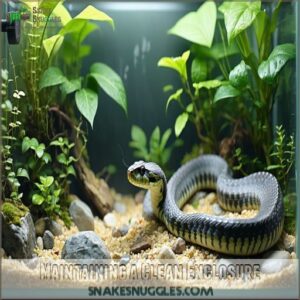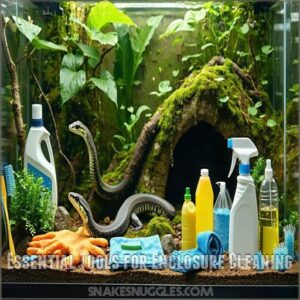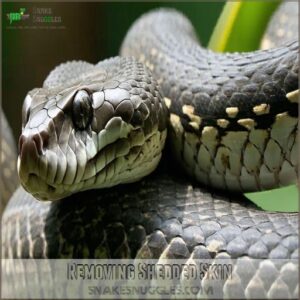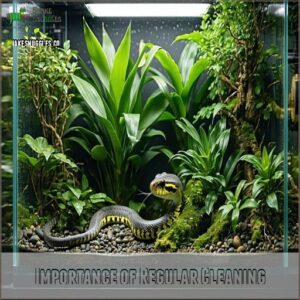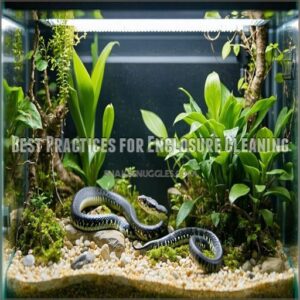This site is supported by our readers. We may earn a commission, at no cost to you, if you purchase through links.
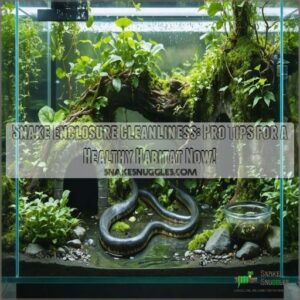
Start by spot-cleaning daily—remove waste, shed skin, and soiled bedding. Replace water and scrub the bowl often; let’s keep that hydration station pristine!
Schedule deep cleaning weekly or monthly, depending on the setup. This means safely relocating your snake, turning off heat sources, and scrubbing every nook with reptile-safe disinfectant. Don’t forget hides, rocks, and decorations—clean them thoroughly and air-dry before returning them.
Clean bedding prevents mold, while proper humidity and ventilation reduce the risk of infections. A clean home equals a healthy, happy snake. Ready to master this?
Table Of Contents
- Key Takeaways
- Preparing The Enclosure for Cleaning
- Cleaning The Enclosure
- Disinfecting The Enclosure
- Cleaning and Disinfecting Accessories
- Maintaining a Clean Enclosure
- Essential Tools for Enclosure Cleaning
- Dealing With Contaminants and Health Issues
- Bioactive Enclosure Cleaning
- Importance of Regular Cleaning
- Best Practices for Enclosure Cleaning
- Frequently Asked Questions (FAQs)
- How often do you need to clean a snake enclosure?
- What happens if you don’t clean your snake cage?
- How do I keep mites out of my snake enclosure?
- What cleaning solution to use for snake enclosure?
- How do I reduce odors in snake enclosures?
- Can plants in enclosures cause hygiene issues?
- How often should I clean humidity gauges?
- What are signs of an unclean enclosure?
- How do I safely remove stubborn stains?
- Conclusion
Key Takeaways
- Spot clean daily to remove waste, shed skin, and soiled bedding, and refresh water to prevent bacteria buildup.
- Deep clean weekly or monthly, depending on your setup, disinfect surfaces, and replace or refresh substrate for a healthy habitat.
- Use reptile-safe cleaning solutions and tools, and ensure proper ventilation and humidity control to avoid mold and respiratory issues.
- Regularly clean and disinfect accessories like water bowls, hides, and decorations to maintain a sanitary and safe enclosure.
Preparing The Enclosure for Cleaning
When preparing to clean your snake’s enclosure, you’ll need to carefully remove your reptile and all its accessories to a safe, temporary habitat.
Make certain you’ve turned off heat sources, put on protective gloves, and create a clean, organized workspace.
Before beginning the thorough sanitization process. Cleaning your snake’s enclosure requires preparation.
Removing The Reptile and Accessories
Before diving into snake enclosure cleaning, you’ll need to safely remove your reptile.
Gently pick up your snake, supporting its entire body to minimize stress during the extraction.
Transfer it to a temporary, secure habitat with proper ventilation and temperature control. Make certain the holding area is escape-proof and comfortable, reducing your snake’s anxiety during the cleaning process. reducing your snake’s anxiety.
Turning Off Heat Sources
After safely removing your snake from its habitat, you’ll want to power down all heat sources with precision.
Unplug heat mats, turn off heat lamps, and disconnect any thermostat controllers.
This step prevents potential electrical hazards and protects your equipment during the deep cleaning process.
To maintain the ideal temperature range of 75-85°F (24-29°C) check temperature guidelines, make certain your equipment is properly calibrated before restarting.
Careful heat source management guarantees both your snake’s safety and your cleaning efficiency.
Protecting Yourself With Gloves
Wearing sturdy, disposable gloves serves as your first line of defense when cleaning a snake enclosure.
These protective barriers shield you from harmful bacteria, parasites, and potential skin irritants lurking in your reptile’s habitat.
Choose nitrile or latex gloves that fit snugly, ensuring maximum hand hygiene and safety during your thorough cleaning routine. Choose nitrile or latex gloves and ensure maximum hand hygiene.
Cleaning The Enclosure
You’ll want to be systematic and thorough when cleaning your snake’s enclosure to maintain a healthy habitat.
Remove all waste and debris.
Carefully clean the substrate, and thoroughly wipe down interior surfaces to prevent potential health risks and guarantee your snake’s best living environment. This will ensure a healthy habitat.
Removing Waste and Debris
Now that you’ve prepped your snake’s habitat, it’s time to tackle waste removal like a pro.
Grab your tools and get ready to clean with precision.
Use a dedicated scoop or tongs to carefully remove solid waste, including feces, urates, and any regurgitated food.
Work systematically, ensuring you don’t miss a spot in your snake’s living space.
Cleaning The Substrate
When diving into substrate cleaning, choose your approach wisely based on the material.
Some substrate types need complete replacement.
Others can be carefully sifted and refreshed. Scoop out solid waste, remove soiled portions, and replace with fresh bedding.
For loose substrates like coconut fiber or bark, gently sift and remove contaminated sections to maintain a clean, healthy environment.
Wipe Down Interior Surfaces
Your snake’s tank interior demands careful attention during cleaning.
For effective cleaning, choose a disinfectant that’s reptile safe.
Use a reptile-safe disinfectant and a soft brush to thoroughly wipe down all surface types, targeting corners and crevices where bacteria hide.
Gentle, consistent strokes prevent scratching delicate enclosure materials.
Rinse thoroughly with clean water, ensuring no chemical residue remains that could harm your scaly friend’s sensitive environment.
Disinfecting The Enclosure
When disinfecting your snake’s enclosure, you’ll need to choose the right reptile-safe disinfectant and apply it carefully to prevent harmful bacterial growth.
You’ll want to scrub thoroughly with a soft brush, ensuring complete surface coverage.
allowing sufficient contact time to effectively eliminate potential pathogens.
Using Reptile-Safe Disinfectant
A reptile-safe disinfectant acts as your first line of defense against harmful bacteria lurking in your snake’s habitat.
Choose specialized solutions designed specifically for reptile environments, avoiding harsh household chemicals that could harm your scaly friend.
Carefully read product labels, selecting disinfectants with proven effectiveness against common reptile pathogens while ensuring maximum safety for your snake’s delicate ecosystem. This is crucial for your snake’s health. Using the right disinfectant is key.
Scrubbing With a Soft Brush
After applying your reptile-safe disinfectant, grab a soft-bristled brush designed for snake enclosure cleaning.
Gentle scrubbing helps remove stubborn grime from delicate surfaces without damaging tank materials, especially those made from recommended snake enclosure materials like melamine-coated wood.
Focus on reaching crevices and corners where bacteria love to hide.
Different brush types work best for various textures – soft brushes for smooth surfaces, slightly firmer ones for textured areas.
Allowing Sufficient Contact Time
Once you’ve scrubbed away the grime, let the disinfectant work its magic.
Dwell time matters big time for killing those nasty bacteria.
Most reptile-safe disinfectants need 5-10 minutes of contact time to zap germs effectively.
Don’t rush this step – patience means a truly clean snake habitat.
Give the disinfectant space to do its job thoroughly and safely.
Cleaning and Disinfecting Accessories
You’ve got to keep those accessories spotless to guarantee your snake stays healthy and safe. Clean and disinfect dishes, hides, and rocks thoroughly to remove harmful bacteria and debris.
Separate Cleaning for Food and Water Dishes
Food and water dish cleaning is all about bacteria prevention and hygiene importance.
Use hot water and reptile-safe cleaning solutions to scrub thoroughly. Clean these separately to reduce cross-contamination risks, as dirty dishes breed germs quickly.
Stick to proper cleaning frequency—daily or whenever soiled—to safeguard your snake’s health. Dishwashing safety keeps harmful pathogens away, ensuring excellent snake enclosure sanitation.
Regular maintenance and cleaning of the water bowl can also help to prevent bacterial and parasite growth, making it essential for maintaining proper humidity levels in your snake’s enclosure.
Cleaning Decorative Items and Hides
Decorative items and hides need careful cleaning to keep your snake enclosure sanitary. Use a reptile hide cleaner, available at popular pet stores like Chewy, to help maintain a hygienic environment.
Focus on safe hide cleaning and decor cleaning methods with these steps:
- Soak hides in warm, soapy water.
- Scrub porous surfaces with a brush.
- Use reptile-safe disinfectant for sterilization.
- Rinse thoroughly to remove residue.
- Air-dry completely before returning.
Consistency keeps a healthy habitat!
Washing Rocks and Accessories
Scrub rocks thoroughly with a soft brush to remove debris, focusing on rock crevices where dirt loves to hide.
Use safe cleaning products, like reptile enclosure cleaning products, to avoid toxic residue.
Rinse carefully, ensuring no disinfectant residues remain, then dry using a towel or air drying methods.
Clean, dry accessories make snake enclosure cleaning safer and your pet healthier.
Maintaining a Clean Enclosure
Keeping your snake’s enclosure clean protects it from health issues like infections and respiratory problems. Stick to a consistent cleaning schedule to maintain a safe, mold-free environment.
Regular Spot Cleaning
Think of spot cleaning as your snake’s daily housekeeping. Remove waste, shedded skin, and soiled bedding promptly to prevent odors and bacteria.
Refresh the water bowl daily for proactive health.
Regular cleaning helps maintain substrate upkeep and overall snake tank hygiene.
A quick once-over keeps your snake enclosure clean while avoiding issues like mold or unhealthy buildups.
Scheduling Deep Cleaning
A consistent snake enclosure cleaning schedule guarantees proper snake tank maintenance.
Plan deep cleaning weekly or monthly based on your setup. Bioactive cleaning might need less frequent attention but demands a yearly overhaul.
Stick to time-tested deep cleaning tips: thoroughly sanitize decorative items, replace substrate, and scrub surfaces.
With a little planning, you’ll keep your snake’s habitat spotless without sacrificing too much time.
Preventing Mold and Mildew
Keeping mold and mildew at bay starts with proper ventilation and humidity control.
Use a substrate choice that dries quickly, replace it regularly, and stick to a solid cleaning frequency.
Wipe down damp areas and avoid over-misting.
A reptile-safe disinfectant is your secret weapon for mold prevention, ensuring snake enclosure cleanliness and a healthier habitat for your reptile.
Essential Tools for Enclosure Cleaning
You’ll need the right tools to keep your snake’s enclosure clean and safe, so don’t skimp on preparation.
Gather reptile-safe cleaners, gloves, scrubbing brushes, and odor-neutralizing solutions for effective, thorough cleaning.
Reptile-Safe Cleaning Solutions
For a healthy habitat, pick reptile-safe cleaning solutions that protect your snake and you! Whether you’re into DIY solutions or commercial brands, prioritize nontoxic products.
Look for:
- Eco-friendly options like vinegar-water solutions.
- Reptile-safe disinfectants with rave product reviews.
- Natural deodorizers like baking soda.
- Sprays and wipes for quick cleans.
Avoid products with harsh chemicals—it’s safety first!
Natural Cleaning Agents
When cleaning your snake’s habitat, natural cleaning agents are game changers.
A vinegar solution (50/50 vinegar and water) works wonders on grime and odors without harming your reptile.
Baking soda is great for deodorizing stubborn smells, and hydrogen peroxide offers a safe, natural disinfectant.
Avoid essential oils—they’re toxic to reptiles. Stick to nontoxic cleaning products designed for reptile-safe use.
Protective Equipment
Don’t skip on protective equipment—it’s your armor!
Gloves shield your hands from bacteria, parasites, and harsh cleaning agents. Add eye protection to guard against splashes, and respirators for fumes during deep cleans. Wear protective clothing to avoid direct contact with waste or chemicals.
Remember, safe disposal of waste and impeccable hand hygiene after handling every tool or surface is key.
Dealing With Contaminants and Health Issues
Contaminants like shed skin, fecal matter, and leftover food can quickly create serious health risks for your snake if not addressed properly.
You’ll prevent issues like mouth rot and respiratory infections by staying consistent with cleaning and monitoring your snake’s habitat daily.
Removing Shedded Skin
After prepping your tools, check shedding frequency to spot leftover bits of shedded skin, as snakes may shed more frequently due to environmental factors.
Stuck shed often clings to toes or tail tips, so assist gently with warm, damp cloths if needed.
Never rush; delicate handling prevents damage. Dispose of skin scraps immediately.
Regular snake habitat cleaning keeps shedding smooth and avoids stuck shed. It’s all part of proper reptile enclosure cleaning!
Dealing With Fecal Matter
How do you tackle fecal matter in your snake’s enclosure for outstanding cleanliness? Stick to these steps:
- Use tongs or gloves to safely handle fecal matter and urates.
- Dispose properly in sealed bags to avoid bacteria spread.
- Spot clean daily to prevent buildup.
- For bioactive setups, make sure waste removal aligns with microfauna efficiency.
- Invest in specialized snake waste disposal products for effective and hygienic cleaning.
Consistency keeps habitats fresh!
Preventing Mouth Rot and Respiratory Infections
Mouth rot and respiratory infections are common snake diseases tied to poor hygiene practices.
Regular cleaning, proper enclosure design, and safe disinfectants are essential for disease prevention.
Stale, damp air invites bacteria—ventilate the enclosure well to avoid this.
Watch for symptoms like mouth swelling or wheezing and act fast. Keeping your snake healthy starts with a clean, well-maintained habitat. Disease prevention is crucial. Common snake diseases include mouth rot and respiratory infections.
Bioactive Enclosure Cleaning
Keeping a bioactive enclosure clean means balancing a natural ecosystem while ensuring your snake’s health.
Regular spot cleaning is key to preventing harmful buildups.
Monitoring humidity and ventilation are also key to maintaining stability.
Spot Cleaning and Deep Cleaning
Spot cleaning in bioactive setups means removing waste daily to maintain balance. Regular cleaning keeps your snake’s micro-habitat thriving. Deep cleaning? That’s your yearly refresh to reset the ecosystem.
- Cleaning frequency matters: Daily spot checks keep things healthy.
- Substrate choice counts: Use biodegradable options.
- Tool recommendations help: Soft brushes and gloves avoid damage.
Snake enclosure maintenance doesn’t need to be overwhelming.
Maintaining Proper Ventilation
Good airflow is key to snake enclosure cleanliness.
Proper ventilation prevents mold and keeps your snake habitat’s humidity and temperature stable.
Use mesh lids or adjustable vents for effective airflow solutions.
Poor ventilation can cause serious health problems, so don’t overlook it. Design the enclosure to balance humidity control while avoiding damp, stagnant air—your snake will thank you! Good airflow is essential.
Monitoring Humidity and Temperature
Keeping your snake habitat comfy means managing humidity control and temperature gradients.
Use quality thermometer types and confirm hygrometer accuracy to track snake habitat humidity and temperature levels. The right balance prevents illnesses.
Ventilation impact matters too—too stuffy? Mold thrives. Too dry? Shedding struggles.
Regular checks during snake habitat cleaning help maintain a cozy, healthy snake enclosure your pet deserves. For example, increasing ventilation in the enclosure, such as using screen lids or drilling holes can help maintain the best humidity levels.
Importance of Regular Cleaning
Regular cleaning keeps your snake’s enclosure free from harmful bacteria, mold, and waste.
These can cause serious health issues like scale rot or infections.
By maintaining a clean habitat, you’ll create a safe, stress-free environment.
This safe, stress-free environment promotes your snake’s overall health and longevity.
Preventing Scale Rot and Respiratory Infections
Snake enclosure cleaning isn’t just housekeeping—it’s health insurance for your pet. Scale rot and respiratory infections often stem from poor hygiene, improper ventilation, or excess moisture.
- Use reptile-safe disinfectants regularly.
- Maintain proper ventilation to prevent bacterial growth.
- Keep humidity control steady to match species needs.
- Replace soiled substrates promptly.
- Quarantine new snakes to avoid spreading illness.
Maintaining a Healthy Environment
A healthy snake habitat isn’t just clean—it’s well-balanced.
Proper enclosure ventilation prevents stale air, while humidity control keeps shedding trouble at bay.
Pick the right substrate to reduce stress and prevent disease.
Daily snake enclosure cleaning and substrate checks are lifesavers for reptile health. Follow a reliable snake habitat cleaning guide to guarantee your pet thrives in a pristine environment.
Promoting Snake Health and Longevity
A clean enclosure isn’t just tidy—it’s your snake’s ticket to a long, healthy life.
Regular snake enclosure cleaning and disinfecting supports immune health, prevents disease, and reduces stress.
Pair cleanliness with proper diet, adequate enclosure size, and veterinary care.
Think of it as creating the perfect reptile spa. Happy, stress-free snakes live longer, shedding and thriving like nature intended.
Best Practices for Enclosure Cleaning
Keeping your snake’s enclosure clean isn’t just about appearances—it’s essential for their health and well-being.
Use pet-safe products.
Avoid harsh chemicals.
Stick to proper cleaning techniques every time.
Researching Pet-Safe Cleaning Products
Finding reptile-safe cleaning products can feel overwhelming, but it’s worth it for your snake’s health.
Check product reviews and ingredient lists to confirm they’re non-toxic.
Compare brands for cost-effectiveness without sacrificing safety.
Look for labels like “reptile-safe disinfectants” or “pet-safe cleaning solutions.”
Trust brands with a strong reputation in reptile care; your snake deserves the best!
Avoiding Harsh Chemicals
Skip harsh chemicals that could harm your snake’s health. Instead, reach for safe cleaning agents and natural disinfectants.
Try these non-toxic choices:
- Vinegar and water: Great for cleaning surfaces without harsh fumes.
- Baking soda: A natural deodorizer for stubborn odors.
- Reptilesafe cleaning solutions: Designed for safety.
- Eco-friendly options: Gentle yet effective.
- Natural cleaning agents: Safe for reptiles and you.
Following Proper Cleaning Procedures
Stick to a cleaning routine and follow these steps religiously.
Always remove waste promptly to prevent buildup.
Use reptilesafe cleaning tools and substrates suited for your snake’s needs. Choose disinfectant types that are safe yet effective, and rinse thoroughly.
Waste disposal should be quick and hygienic.
Regular snake enclosure cleaning creates a healthy home, keeping your reptile stress-free and thriving.
Frequently Asked Questions (FAQs)
How often do you need to clean a snake enclosure?
Spot clean daily to remove waste and debris.
Deep clean weekly, scrubbing surfaces and disinfecting accessories.
Replace bedding monthly or as needed.
Keep it consistent; a clean enclosure keeps your snake healthy and stress-free.
What happens if you don’t clean your snake cage?
A dirty snake cage is like leaving food out for bacteria and parasites.
Over time, your snake’s health suffers—mouth rot, scale infections, and respiratory issues creep in, leading to stress, illness, and potentially death.
How do I keep mites out of my snake enclosure?
Quarantine new snakes.
Regularly clean and disinfect the enclosure, and replace substrate frequently.
Treat the enclosure with reptile-safe mite sprays as a precaution.
Check your snake’s health routinely to catch and prevent infestations early.
What cleaning solution to use for snake enclosure?
Did you know regular cleaning cuts snake infections by 70%?
Use a 50/50 mix of white vinegar and water or reptile-safe disinfectants.
Always rinse thoroughly, let it air dry, and skip harsh chemicals!
How do I reduce odors in snake enclosures?
Keep odors at bay by replacing soiled bedding often, removing waste daily, and cleaning with a reptile-safe disinfectant.
Use baking soda to neutralize smells.
Maintain proper ventilation and avoid leaving uneaten food in the enclosure.
Can plants in enclosures cause hygiene issues?
Lush plants can turn a reptile haven into a bacteria paradise if you’re not careful.
Moldy leaves, trapped moisture, and hidden waste boost hygiene risks.
Stick to low-maintenance plants and clean debris regularly.
How often should I clean humidity gauges?
You should clean humidity gauges weekly to remove dust and bacterial build-up.
Use a reptile-safe disinfectant, rinse thoroughly, and dry completely.
Regular care guarantees accuracy and prevents issues like mold or harmful bacterial growth.
What are signs of an unclean enclosure?
An unclean enclosure leads to foul odors, visible mold, and excessive buildup of feces or urates.
Poor appetite, dull or uneven shedding, and abnormal behavior like lethargy are also common.
Increased risk of infections like scale rot or respiratory issues is another significant concern.
How do I safely remove stubborn stains?
Stubborn stains can feel like battling a brick wall.
mix baking soda and water into a paste, scrub gently with a soft brush, then rinse thoroughly.
Avoid harsh chemicals to keep your setup reptile-safe.
Conclusion
Keeping up with snake enclosure cleanliness is like giving your pet a fresh start every day. By spot-cleaning regularly and scheduling deep cleaning, you’re preventing harmful infections and keeping their habitat comfortable.
Use reptile-safe cleaners, maintain proper ventilation, and control humidity to create a healthy environment.
Don’t forget to clean hides, decorations, and water bowls thoroughly.
A clean enclosure isn’t just about looks—it’s key to your snake’s health, happiness, and long life. Stay consistent, and you’re golden!

